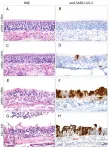(Press-News.org) More than 10 million people are sickened by tuberculosis (TB) globally each year, resulting in 1.5 million deaths. Yet, as many as two billion people are infected with Mycobaterium tuberculosis, the bacterium that causes tuberculosis, and are otherwise healthy and asymptomatic. Scientists who study TB look at those individuals who can tolerate and contain the infection in hopes of developing better treatments and vaccines.
The key feature of tuberculosis infection in humans is the formation of granulomas, or clusters of immune cells in the lungs that contain the infection. These granulomas contain B cells, all-purpose immune cells that perform a variety of functions, from producing antibodies to regulating the activity of other cells. For years, researchers assumed that these B cells must be performing a specific direct function in the granulomas to control TB infection, but in a new study, scientists from the University of Chicago and Washington University in St. Louis show that these B cells are actually directing reinforcements to help.
In the study, published in Nature Immunology, the team eliminated different expected B cell functions one by one in animal models of TB to narrow down the possibilities for which components prevented progression of disease. Nothing seemed to make a difference, whether removing plasma cells that produce antibodies or knocking out other B cell functions that produce immune signaling molecules.
“No matter what we knocked out individually in B cells, it didn’t make a difference. All the predicted functions that people think B cells are doing were not what they were doing in the lung for protection against TB,” said Shabaana Khader, PhD, the Bernard and Betty Roizman Professor and Chair of Microbiology at UChicago and senior author of the study. “But they needed to be there, because when we knocked TB-specific B cells out completely, you start seeing that the mice get sick. So, we knew that it wasn't any of these usual suspects.”
In addition to the results in mice, the team saw the same results when they completely deleted B cells in non-human primate models.
B cells aren’t the only immune cells present in granuloma tissue. T cells, another important white blood cell of the immune system, also play a part, specifically CD4+ or “helper” T cells that can initiate immune responses. Both B and T cells interact to control tuberculosis progression, but until this study, just how much either contributed and interacted wasn’t completely clear.
As Khader and her team narrowed down the potential functions of the B cells, they saw that the helper T cells express transcription factors that in turn generate T cell subtypes, including T follicular helper (Tfh)-like cells that localize within the granuloma tissue. It is these Tfh-like cells that activate macrophages to keep the TB infection in check by surrounding and killing infected cells, but the B cells tell them where to go and localize within the granulomas. So, instead of directly controlling TB themselves, B cells are pointing the Tfh-like cells in the right direction to do the job.
“An effective way to activate macrophages is to get Tfh-like cells to come there and activate them, and that's what the B cell is doing,” Khader said.
The only vaccine for tuberculosis was first produced in 1921, and while it’s effective in preventing some forms of childhood TB, its protection is widely variable for adults. Understanding how some people are able to control TB infection naturally could help develop better versions in the future.
“If you can initiate the protective immune response much earlier, the bacteria will never get a chance to establish infection in the lung,” Khader said. “We could make a vaccine that generates the right kind of immune response so that when you get exposed to the bacteria, you won't even carry the latent infection. So, our resolution for vaccine design is much cleaner now since we know what cell types to target in the lung.”
The study, “Antigen-specific B cells direct T follicular- like helper cells into lymphoid follicles to mediate Mycobacterium tuberculosis control,” was supported by the National Institutes of Health and Washington University in St. Louis. Additional authors include Rosemary V. Swanson, Ananya Gupta, Lan Lu, Bruce A. Rosa, Sadia Akter, Shibali Das, Mushtaq Ahmed, Ekaterina Esaulova, Maxim N. Artyomov, Jennifer Gommerman, Smriti Mehra, and Makedonka Mitreva from Washington University in St. Louis; Taylor W. Foreman from the Tulane National Primate Research Center; Jose Alberto Choreno-Parra and Joaquin Zuniga from Instituto Nacional de Enfermedades Respiratorias Ismael Cosio Villegas, Mexico; Stanley Kimbung Mbandi and Thomas J. Scriba from the University of Cape Town, South Africa; Maria de la Luz Garcia-Hernandez and Javier Rangel-Moreno from the University of Rochester; and Dhiraj K. Singh and Deepak Kaushal from the Texas Biomedical Research Center.
END
How two different types of immune cells help two billion people keep tuberculosis in check
New research shows how B cells direct T cells to granuloma tissue in the lungs where they can activate macrophages to neutralize TB infections.
2023-04-03
ELSE PRESS RELEASES FROM THIS DATE:
Do Earth-like exoplanets have magnetic fields? Far-off radio signal is promising sign
2023-04-03
Earth's magnetic field does more than keep everyone's compass needles pointed in the same direction. It also helps preserve Earth’s sliver of life-sustaining atmosphere by deflecting high energy particles and plasma regularly blasted out of the sun. Researchers have now identified a prospective Earth-sized planet in another solar system as a prime candidate for also having a magnetic field — YZ Ceti b, a rocky planet orbiting a star about 12 light-years away from Earth.
Researchers Sebastian Pineda and Jackie Villadsen observed a repeating radio signal emanating from the star YZ Ceti using the Karl G. Jansky Very Large Array, a radio telescope ...
Higher lithium levels in drinking water may raise autism risk
2023-04-03
Pregnant women whose household tap water had higher levels of lithium had a moderately higher risk of their offspring being diagnosed with autism spectrum disorder, according to a new study led by a UCLA Health researcher.
The study, published April 3 in JAMA Pediatrics, is believed to be the first to identify naturally occurring lithium in drinking water as a possible environmental risk factor for autism.
“Any drinking water contaminants that may affect the developing human brain deserve intense scrutiny,” said lead study author Beate Ritz, MD, PhD, professor of neurology in the David Geffen School of Medicine at UCLA ...
Nasal vaccine to prevent COVID-19 passes first tests
2023-04-03
Since the beginning of the COVID-19 pandemic, researchers have been working on mucosal vaccines that can be administered through the nose. Now, scientists in Berlin have developed a live attenuated vaccine for the nose. In “Nature Microbiology”, they describe the special immune protection it induces.
Joint press release by Freie Universität Berlin, Max Delbrück Center and Charité – Universitätsmedizin Berlin
Coronaviruses spread primarily through the air. When infected people speak, cough, sneeze or laugh, they expel droplets of saliva containing the virus. Other people then breathe ...
Research finds global emissions of several banned ozone-destroying chemicals are increasing
2023-04-03
The research, published today in Nature Geoscience and led by the University of Bristol and National Oceanic and Atmospheric Administration (NOAA), puts the rise in part down to the chemicals, known as chlorofluorocarbons or CFCs, being used to make other ozone-friendly alternatives to CFCs. This is an exception allowed under the Montreal Protocol, but contrary to its wider goals.
Lead author Dr Luke Western, a Research Fellow at the University of Bristol and researcher at the NOAA’s Global Monitoring Laboratory (GML), said: “We’re paying attention to these emissions now because of the success of the Montreal Protocol. CFC ...
Early menopause, later start to hormone therapy may increase risk of Alzheimer’s disease
2023-04-03
BOSTON — Women are more likely than men to develop Alzheimer’s disease (AD), with women making up two-thirds of the population living with AD. A new study, led by Mass General Brigham researchers, sheds light on the relationship between the risk of Alzheimer’s disease and age of menopause and use of hormone therapy (HT). The results, published in JAMA Neurology, indicate that early age at menopause may be a risk factor for AD dementia, but that women who were prescribed HT around the age of menopause onset did not show increased risk.
“HT is the most reliable way to ameliorate severe menopause symptoms, ...
Comparison of postpartum opioid prescriptions before vs during pandemic
2023-04-03
About The Study: In this study of 460,000 privately insured postpartum women, patients who gave birth to a single, live newborn after March 2020 were more likely to fill more potent and more frequent opioid prescriptions than patients who gave birth prior to March 2020. Increases were larger for patients delivering via cesarean birth than those delivering vaginally. Increases in opioid prescriptions may be associated with increased risk of opioid misuse, opioid use disorder, and opioid-related overdose among postpartum women.
Authors: Shelby R. Steuart, M.P.A., of ...
Genetics of preterm birth and pregnancy length clarified
2023-04-03
New knowledge of the genetic factors behind premature delivery and gestational duration has now emerged. Findings presented by a major international study under the aegis of the University of Gothenburg include the ways in which, before birth, the woman’s and the unborn child’s genes have mutually antagonistic effects.
These results, now published in the journal Nature Genetics, enhance the potential for long-term development of drugs to induce parturition (birth) and — even more importantly — achieve the goal of preventing preterm births.
Globally, preterm (or premature) birth is the most frequent immediate cause of death among newborns and children ...
More U.S. prostate cancer patients choosing active surveillance
2023-04-03
The number of prostate cancer patients in the U.S. choosing active surveillance over surgery or radiation has rapidly increased since 2010, rising from 16% to 60% for low-risk patients and from 8% to 22% for patients with favorable intermediate-risk cancers, according to a study published today in JAMA Internal Medicine.
Active surveillance includes actively monitoring prostate cancer for progression, with the intention to intervene with surgery or radiation therapy if the cancer progresses.
It is the preferred treatment option for men with low-risk ...
Double-slit experiment that proved the wave nature of light explored in time
2023-04-03
Imperial physicists have recreated the famous double-slit experiment, which showed light behaving as particles and a wave, in time rather than space.
The experiment relies on materials that can change their optical properties in fractions of a second, which could be used in new technologies or to explore fundamental questions in physics.
The original double-slit experiment, performed in 1801 by Thomas Young at the Royal Institution, showed that light acts as a wave. Further experiments, however, showed that light actually ...
Researchers show lorlatinib is safe and effective for patients with ALK-driven relapsed/refractory high-risk neuroblastoma
2023-04-03
Philadelphia, April 3, 2023—In a significant step for the treatment of neuroblastoma, an international group of researchers led by Children’s Hospital of Philadelphia (CHOP), Winship Cancer Institute of Emory University and the New Approaches to Neuroblastoma Therapy (NANT) Consortium has shown that the targeted therapy lorlatinib is safe and effective in treating high-risk neuroblastoma. The findings, published today in Nature Medicine, have led to a major amendment in a phase 3 Children’s Oncology Group (COG) clinical trial, which has incorporated lorlatinib for newly diagnosed ALK-driven high-risk neuroblastoma, ...
LAST 30 PRESS RELEASES:
Decoupling the HOR enhancement on PtRu: Dynamically matching interfacial water to reaction coordinates
Sulfur isn’t poisonous when it synergistically acts with phosphine in olefins hydroformylation
URI researchers uncover molecular mechanisms behind speciation in corals
Chitin based carbon aerogel offers a cleaner way to store thermal energy
Tracing hidden sources of nitrate pollution in rapidly changing rural urban landscapes
Viruses on plastic pollution may quietly accelerate the spread of antibiotic resistance
Three UH Rainbow Babies & Children’s faculty elected to prestigious American Pediatric Society
Tunnel resilience models unveiled to aid post-earthquake recovery
Satellite communication systems: the future of 5G/6G connectivity
Space computing power networks: a new frontier for satellite technologies
Experiments advance potential of protein that makes hydrogen sulfide as a therapeutic target for Alzheimer’s disease
Examining private equity’s role in fertility care
Current Molecular Pharmacology achieves a landmark: real-time CiteScore advances to 7.2
Skeletal muscle epigenetic clocks developed using postmortem tissue from an Asian population
Estimating unemployment rates with social media data
Climate policies can backfire by eroding “green” values, study finds
Too much screen time too soon? A*STAR study links infant screen exposure to brain changes and teen anxiety
Global psychiatry mourns Professor Dan Stein, visionary who transformed mental health science across Africa and beyond
KIST develops eco-friendly palladium recovery technology to safeguard resource security
Statins significantly reduce mortality risk for adults with diabetes, regardless of cardiovascular risk
Brain immune cells may drive more damage in females than males with Alzheimer’s
Evidence-based recommendations empower clinicians to manage epilepsy in pregnancy
Fungus turns bark beetles’ defenses against them
There are new antivirals being tested for herpesviruses. Scientists now know how they work
CDI scientist, colleagues author review of global burden of fungus Candida auris
How does stroke influence speech comprehension?
B cells transiently unlock their plasticity, risking lymphoma development
Advanced AI dodel predicts spoken language outcomes in deaf children after cochlear implants
Multimodal imaging-based cerebral blood flow prediction model development in simulated microgravity
Accelerated streaming subgraph matching framework is faster, more robust, and scalable
[Press-News.org] How two different types of immune cells help two billion people keep tuberculosis in checkNew research shows how B cells direct T cells to granuloma tissue in the lungs where they can activate macrophages to neutralize TB infections.




